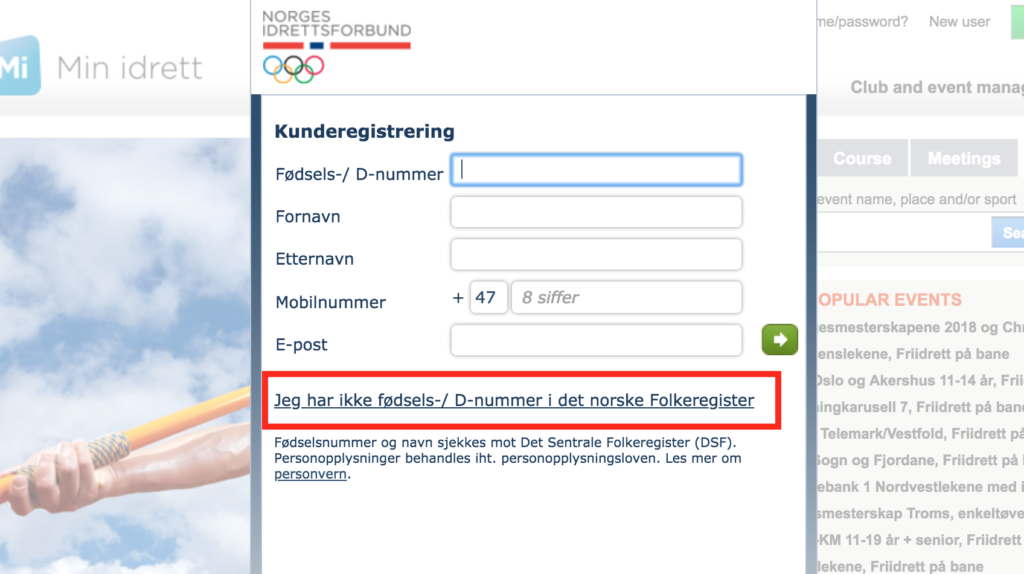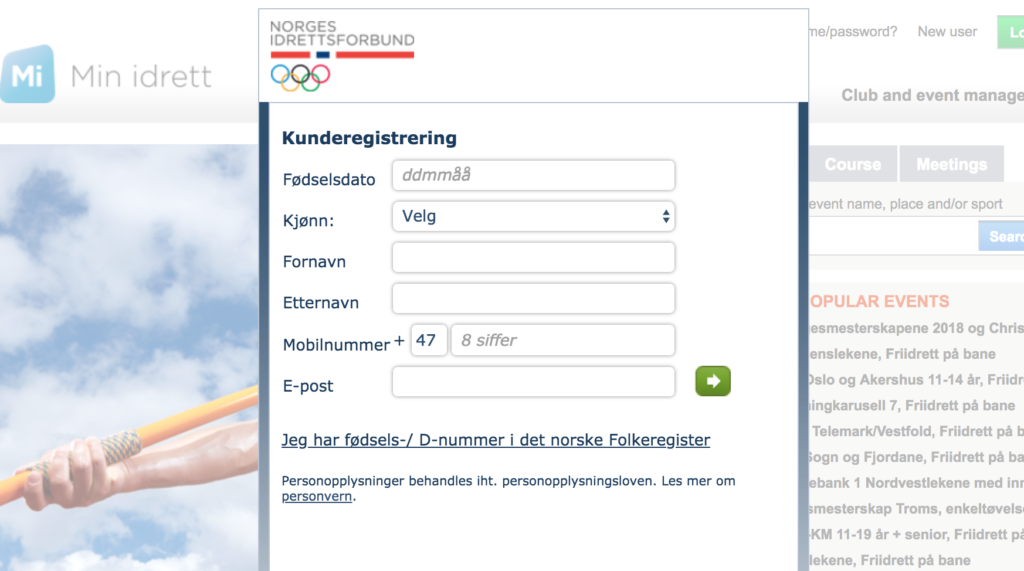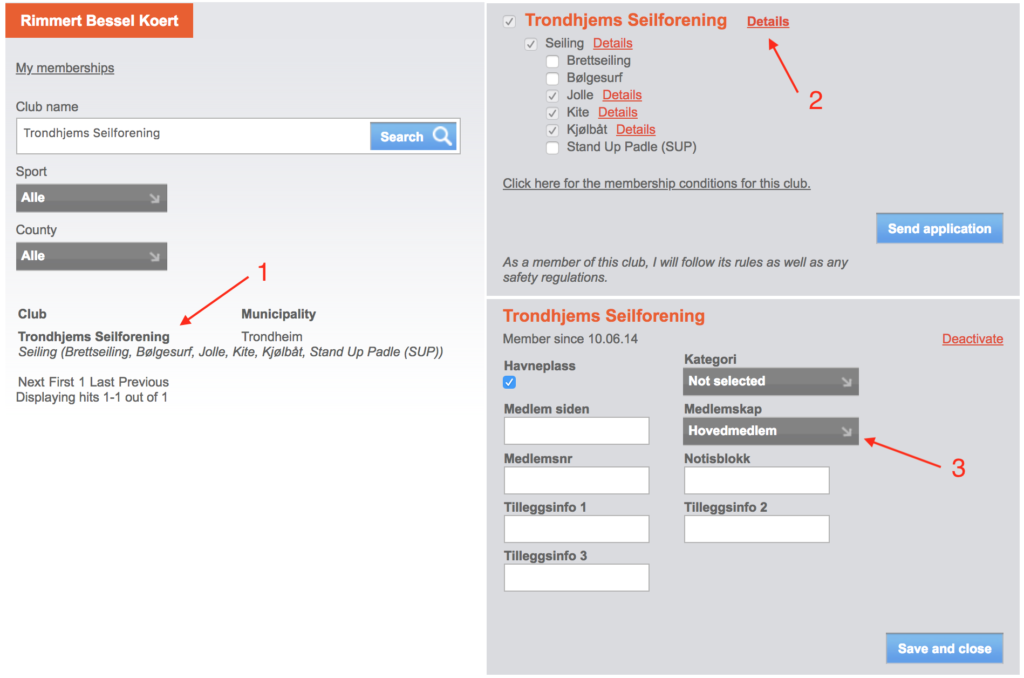Frequently Asked Questions
How to become a member?
The first training is for free. The second training we ask you to become a member of TSF, so for your first training, you can hop to step 2 and 3, thereafter come back to step 1 ;-). So follow the following three steps and you should be good to go:
- Join the Trondheim Yngling Facebook group to stay up to date: FB Group
- Say that you had liked to start training on the FB page, so we can find a suitable boat for you.
- Did you like it and want to continue? Become a TSF member (see below)
- Pay for the training fee: Contact Rimmert for 2020 link.
Member TSF via Minidrett
Here we will describe how you become a member of TSF on the Minidrett site. You need either a Norwegian person number, but it should also work for non-Norwegians. If you still have trouble, here is a form as a backup, but please, try the following first!
- Go to https://minidrett.nif.no/
- Click on English and then “new user”. If you do not have a personal or D-number, click on the following: “Jeg har ikke fødsels-/ D-nummer i det norske Folkeregister”

- Then you should land on the following page, where you only have to fill out your date of birth, and you can use an international phone number:

-
When you are ready with making a new user and are logged in. Go to “Membership/Medlemskap”. Then click on: “Find new club/Finn ny klubb” NB! You have to search exactly for: “Trondhjems Seilforening” in order to find TSF. Then click on Trondhjems Seilforening. Are you a youth member or student, please click on the following three things:
-

1. Click on “Trondhjems seilforening” then the right hand side should show, just tick some of the boxes.
2. Click on “Details”,
3. and 3 is now based on your age.
Click “save and close”, and “Send application”. -
You will not get any question any more which membership you apply for. It is based on age. So >25 is “Hovedmedlem”. Or “Student / Young” until the age of 25, so <26.
-
Last but not least, go in the menu to Payment / Betaling and pay your membership fees. Then you can download the PDF under “Membership / Medlemskap”. This will become available once the Treasurer has approved your membership, this may take a bit of time.
What kind of boat is used? (The Yngling keelboat)

The Yngling is a popular entry level keelboat designed in Norway that is very safe and easy to handle. It has been used in the Olympic Games as well as other major sailing competitions and is still used to this day. It is virtually unsinkable due to its reserved buoyancy and quite forgiving in its response. Designed for three youths as a crew, though it can easily be managed by two sailors if needed. It takes about 10 minutes for the crew to prepare the boat and it is easy to use two paddles and row the boat in or out of the marina if there is little wind.
The boat is 6.35 m long, with a waterline length of 4.7 m, a weight of 645 kg and a sail area of around 14m2. It has a mainsail which is a big sail that gives driving power and stability, a headsail called a jib in the front that gives speed and helps the boat go towards the wind and, finally, a spinnaker (yellow in the figure) which is big and lightweight sail that looks like a half balloon or kite that helps the boat travel with the wind coming from the rear since the jib is not good at that task.
The Yngling can be a good boat to learn both competitive and cruising sailing in since it has most of the sail trim adjustments (“settings”) that bigger sailboats have and it gives quick and strong feedback on adjustments, something that is key in learning how to trim and sail. Typical crew roles on the Yngling are the helmsman who sits at the aft (rear side) and controls the rudder with one hand and sometimes the mainsail with the other. The bowman/forehand that controls the headsail/jib and also is responsible for setting the pole for the spinnaker. Last but not least, the middle hand who is responsible for balancing the boat with their weight, helping the helmsman with the mainsail and trim and also trimming the spinnaker when it is used.
The Trondheim Sailing Club owns two Ynglings, the students’ club NTNUI owns three and there are at least three more boats that compete regularly.
How to stay up to date?
Most of the last minute things are communicated on our Facebook Group page. Please become a member there in order to keep up to date: Facebook Yngling Group Trondheim
When? Season start?
We have two seasons, a spring and autumn season.
- The spring season usually starts right after easter, and ends in June (15ish).
- The autumn season usually starts around the 15th of August to the 1st of October.
We train every Monday, and start at 17:30. Somewhere in September we start at 17:00, because of the early darkness.
Usually the boats are rigged before the briefing at 17:30, then the briefing starts at the terras outside of TSF and then everyone gets out on the water.
The regattas on Wednesday have their start signal at 18:00 sharp. Which means usually you need to start at 17:00 in order to get out on the water at the start line in time.
What does it cost?
Sailing is not the cheapest sport, but the Ynglings are one of the cheaper boats to sail with.
We will give a list of the cost, and also three examples.
- Membership TSF (2020 prices):
- Adult: kr. 905,- (Additional family members: kr. 590,-)
- Student kr. 400,- * until the age of 25, above that you pay as a regular member.
- Updated prices: https://www.trondhjems-seilforening.no/medlemer/medlemskap/
- Regatta fee per boat kr. 750-800 per season (whole year 1500,-) (Not for NTNUI boats in 2020)
- NYK member kr. 300,- (crew members: kr. 100,-)
- NSF (Norges Seilforbundet) license kr. 430,- for the whole year
- Winter storage on land: kr. 1500,-
- Summer storage on land: kr. 1500,-
I am a student
If you are a student up to 25, we count you as “youngster” and you will have a couple of things reduced in cost. Are you student above 25, we don’t reduce prices any more, and are equal to normal members in TSF.
So: Student <=25:
- Student/youngster price TSF membership: kr. 400,-
- Training fee: 500,-
Student >25
- Regular TSF fee: kr. 905,-
- Regular training fee: 800,- per season / kr. 1500,- a year
Participating in the regattas: For 2020 you do not have to pay the regatta fee, as long as it is an NTNUI boat (Ari, Emma Tallulah, Märtha)
I only participate on the Monday training
If you only participate on the Monday training, you will need to be member in TSF, and you if you are crew dedicated in a boat, you will have to discuss with the boat owner what he/she wants you to pay.
I will participate on the Monday training and join in on the Wednesday Regattas
You need to be a member of TSF, plus you will need to pay the regatta. Usually the regatta fee is shared within the boat, so 1/3 of the fee above.
I will participate on Monday and I want to rent one of TSF their boats
You need to pay the TSF membership, and you can rent either Kon Leaky or Frigg for the whole year for kr. 7000,-/5000,- which then also covers any material you will need to buy for the boat. But be aware that we expect you to put some love into the boats, which means that we expect you to repair stuff that gets broken aboard. Or that it is send for repair if needed. The cost of those repairs are covered, but it will take some of your time.
I want to participate in the Nationals this year
You need to be a member of TSF, you will probably join all regatta’s in the season. Furthermore you will need to travel to Horten for the Nationals/NM of this year. Driving there, plus the cost of the NSF membership and NYK membership. Which basically comes down to this:
- TSF membership (kr. 905,- / kr. 400,-)
- Regatta (800,- / 3 = kr. 267,-)
- NSF Lisence kr. 430,-
- NYK member one time: kr. 100,-
- Travel to Horten estimate: kr. 2000,-
- Stayover in Horten p.p.: kr. 200,–
I have my dedicated team and my own boat and will participate in the Worlds.
Are you really reading this section? You know what it costs. Basically checking all of the boxes above on the list, plus the extra love and care you put into your boat, your equipment and all of the clothing you have bought so far.
What should I wear?
This section mainly focuses on clothing since most of the boat equipment is provided on the boats (i.e. life vests, sails, paddles). The clothing equipment required for sailing an Yngling depends mainly on two factors, namely weather conditions and level of competitiveness. In order to provide some meaningful tips we have divided it into two weather categories.
Spring/Autumn weather:
During the start of the sailing season around March, it can be pretty cold and windy in Trondheim. Students or leasure sailors can use simple waterproof clothes (e.g. skiing clothes) instead of investing a lot on sailing specialized clothing. We suggest this while trying sailing. More competitive crews wear some wool layers and special clothes called foul-weather gear. They mainly consist of a waterproof set of trousers with shoulder straps and reinforced fabric on the backside and knees, and waterproof sailing jackets that make it easy to maneuver and have some protection for water coming through the neck and the sleeves. Cheap sailing boots can be useful, especially since there is usually water spray from waves and some amount of water inside the boat. Crewmembers who work a lot with ropes usually like to wear wear resistant gloves that keep their hands dry and relatively warm on a typical race or training that lasts for 2-4 hours.
Summer weather:
With the sun setting later and higher temperatures it is easier to get warm in the heat of a race or training. A simple t-shirt and waterproof layer should work fine in these conditions. Gloves help a bit especially for the jib trimmer since the jib rope can be quite powerful on strong winds.
Sunscreen could be a good idea, as well as polarized sunglasses that filter out some of the water reflections, helpful when trying to locate a race marker on a water surface with sun reflections and protection from salty water spray.
